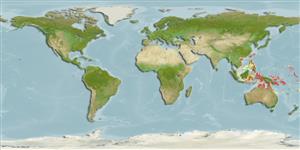>
Gobiiformes (Gobies) >
Gobiidae (Gobies) > Gobiinae
Etymology: Fusigobius: Latin, fusus = spindle + Latin, gobius = gudgeon (Ref. 45335); aureus: aureus (Latin for yellow) referring to the many 'golden-yellow' spots scattered on the body and fins (Ref. 31555).
Environment: milieu / climate zone / depth range / distribution range
Écologie
marin récifal; profondeur 5 - 25 m (Ref. 90102). Tropical
Western Central Pacific: Indonesia, Solomon Islands, and the Coral Sea.
Taille / Poids / Âge
Maturity: Lm ? range ? - ? cm
Max length : 3.5 cm SL mâle / non sexé; (Ref. 31555)
Description synthétique
Clés d'identification | Morphologie | Morphométrie
Épines dorsales (Total) : 7; Rayons mous dorsaux (Total) : 9; Épines anales: 1; Rayons mous anaux: 8. Pectorals large and rounded; pelvic fins largely separated but united at base, the connecting membrane very short and concave in outer margin, without inter-spine frenum (Ref. 31555). Body with a row of golden-yellow spots along mid-line of lateral surfaces and with some rows of smaller golden-yellow spots on both dorsal and ventral surfaces. An oblique, yellow line on cheek and snout. Caudal base with a diaper-shaped black blotch. Dorsal and caudal fins with some rows of smaller golden-yellow spots. First dorsal with a large black blotch, with its lower half tinged orange. Pelvic fins largely separated except for a limited linkage by a very narrow connecting membrane (Ref. 31555); characterized further by having rounded caudal fin; longitudinal scale series 24-25; ctenoid body scales becoming cycloid anterior to pectoral and pelvic fins; absence of scales on operculum; opening of gill extending to or almost to vertical at posterior edge of preopercle; depth of body 4.3-4.8 in SL (Ref. 90102).
Inhabits seaward reefs in 5-25 m (Ref. 90102).
Life cycle and mating behavior
Maturities | Reproduction | Spawnings | Egg(s) | Fecundities | Larves
Chen, I.-S. and K.-T. Shao, 1997. Fusigobius aureus, a new species of gobiid fish (Perciformes, Gobiidae) from Flores Island, Indonesia. Acta Zool. Taiwanica 8(2):87-92. (Ref. 31555)
Statut dans la liste rouge de l'IUCN (Ref. 130435)
Menace pour l'homme
Harmless
Utilisations par l'homme
Outils
Articles particuliers
Télécharger en XML
Sources Internet
Estimates based on models
Preferred temperature (Ref.
123201): 27.4 - 29.4, mean 28.8 °C (based on 1078 cells).
Phylogenetic diversity index (Ref.
82804): PD
50 = 0.5005 [Uniqueness, from 0.5 = low to 2.0 = high].
Bayesian length-weight: a=0.01023 (0.00477 - 0.02194), b=3.02 (2.84 - 3.20), in cm total length, based on LWR estimates for this (Sub)family-body shape (Ref.
93245).
Niveau trophique (Ref.
69278): 3.2 ±0.3 se; based on size and trophs of closest relatives
Résilience (Ref.
120179): Haut, temps minimum de doublement de population inférieur à 15 mois (Preliminary K or Fecundity.).
Fishing Vulnerability (Ref.
59153): Low vulnerability (10 of 100).
